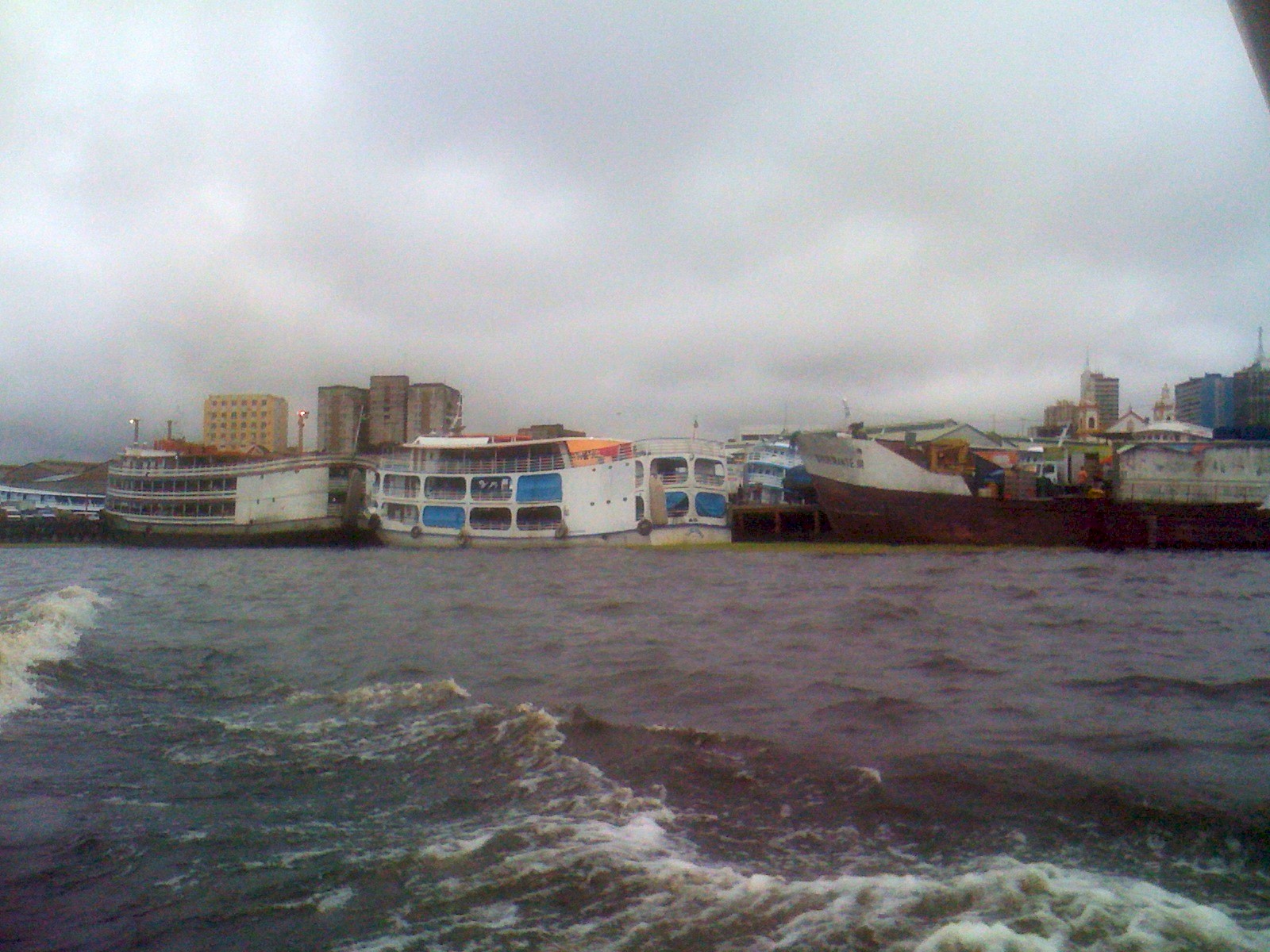MANAUS, Brazil — A cloudburst heralding the start of the rainy season had just passed, leaving us with a free afternoon and comfortable conditions to see one of the Amazon River’s more impressive sights. All we needed was a boat and someone to drive it.
An enterprising hotel concierge made the arrangements. Less than an hour later, after a brief stop at a floating gas station (complete with convenience store) to fill the outboard’s fuel tank, we were on our way to the “meeting of the waters,” where the near-black Rio Negro joins, but does not mix with, the silty beige current of the Solimoes das Aguas, which is what Brazilians call the main stem of the Amazon upstream of the meeting point.
For about five miles, the two currents flow side by side through the enormous channel. The Solimoes, fed by glaciers high in the Peruvian Andes, is 10 degrees cooler and considerably less acidic than the 82-degree Rio Negro, which rises in the lower hills of southern Colombia. The Rio Negro also moves at a more leisurely pace than the Solimoes. So the two streams go their separate ways in the same river, like the tourists and office workers who share the sidewalk along Manhattan’s Fifth Avenue.
Our guide turned upstream and stopped the boat when we arrived at the meeting point. On our left ran the Solimoes; on our right, the Rio Negro. A few other nearby parties took advantage of the junction’s rich fishing opportunities: two men in a small boat, a scattering of hawks and a pod of dolphins, contentedly making their living nearly 1,000 miles from the nearest salt water.
The guide invited us to trail our hands in the water so we could feel the difference between the two currents. But we were not very enthusiastic, having just learned that the river has a healthy population of piranhas.
Across the water and just upstream, on the left bank of the Solimoes, a floating village — composed of about 30 families — lives in houses built on log rafts. The houses, along with the village’s school, store and church, rise and fall with the river, whose level can fluctuate 30 feet between rainy and dry seasons. There are no roads and no sidewalks, but there are plenty of caiman skins (the local version of an alligator hide) nailed to the walls of the houses as souvenirs.
All in all, this is pretty much what I expected to see when we came to Manaus. Rainforest, river, wildlife, local cultures: everything that might have been on my eco-tourism checklist.
But on the right bank of the Rio Negro, looking upstream toward Manaus, the view was not what I expected to find in the Amazon. It was what I would have expected to find in New Jersey.
For mile after mile, the Manaus side of the Rio Negro was lined with ship yards, container ports, factories and oil refineries. In several stretches, welders’ torches shimmered like Christmas-tree lights as enormous river barges underwent repairs. Ocean-going freighters shared the channel with overnight passenger boats that connect the river towns, offering a few air-conditioned cabins for the affluent and space to hang a sleeping hammock for the rest.
I was baffled at first. What could possibly fill the thousands of shipping containers I saw piled at least 100 feet high on the docks? I had expected some port activity, because Manaus is a city of 2 million people and the shipping hub for a vast region of forest and rivers. Brazil is a major producer of all sorts of commodities, and is experiencing a boom led by Asian demand. But how much tropical hardwood and exotic fruit does anybody, even China (which overtook the United States last year to become Brazil’s largest trading partner), really need? And why would anyone send a sea-going freighter 1,000 miles from the sea to get repaired?
It turns out that Asian demand is not the whole story. Industry in Manaus is the product of a half-century of tax incentives and other government inducements to create an economic underpinning for northern Brazil. It seems to have worked. Manaus today produces cell phones, motorcycles, computers, lenses and soap, among other goods, for domestic consumption as well as export.
Manaus recently got its second upscale, air-conditioned shopping mall. We stopped there for lunch at a food court that was far nicer than at most American malls. More than a dozen high-rise apartment towers, all built since 1985, overlook the Rio Negro in the city’s toniest neighborhood.
This is still, in many ways, a frontier city. A serviceable highway leads north and can take you, if you have a sturdy vehicle and a lot of guts, all the way to Caracas, Venezuela. But the only other highway out of town leads south to the smaller Amazonian city of Porto Velho. And travel even to Porto Velho is possible only in the dry season and with a four-wheel-drive. Otherwise, access is by air and by water. Some stretches of the river near downtown Manaus look like a busy Florida intersection, with three or four gas stations facing one another. Except that here, they all float.
A day later and 65 miles to the north, we saw toucans and capuchin monkeys in the canopy, bats in the caves, giant ant nests hanging from the trees. An iridescent blue Morpho butterfly, about the size of a robin, flitted past us. Our local guide spotted coati tracks in a streambed. A few minutes later, as we drove up the road alongside the stream, we spotted the coati.
There’s nothing small about the Amazon. From butterflies to ant colonies to shipyards, a big surprise seems always to wait around the next bend in the river.










January 4, 2011 - 9:45 am
Thanks for a nice, balanced, accurate, well-written article. You seem to have enjoyed your visit, which is great. The only thing I would add is that you will only find piranhas – and most other fish – in the shallower stretches of the river (so no problem trailing your hands in the water at the meeting of the waters!). Having said that, I had a guest once who insisted on getting out of my boat to swim through the meeting. He survived the experience (with a big grin on his face), but sooner him than me 🙂